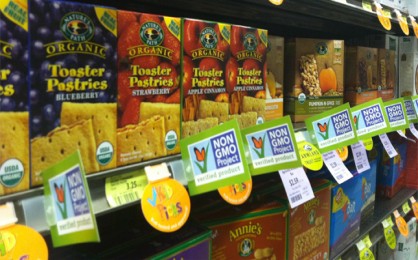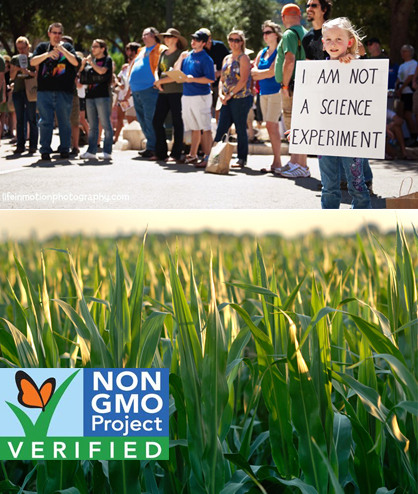The Non-GMO Project Explains Risks and Shares Tips on Going GMO-Free
Though many have raised questions about the safety of genetically modified organisms, or GMOs, they are currently present in about 75 percent of packaged foods. Nearly 50 other countries now have mandatory labeling laws; however, the U.S. is not of them, making it difficult for consumers to make informed decisions about what they eat. The Non-GMO Project, a non-profit that uses a rigorous testing system to verify and label products that are GMO-free, is leading the charge to preserve the non-GMO food supply and protect consumer choice at the grocery store.
GMOs are plants and animals created through gene splicing techniques to merge DNA from different species to achieve desired traits. According to the Non-GMO Project, this “experimental&ddquo; technology creates “unstable combinations of plant, animal, bacterial and viral genes that cannot occur in nature or in traditional crossbreeding.” Though the corporations that create GMOs make big promises about potential benefits, Courtney Pineau, assistant director of the Non-GMO Project, argues that this technology really only serves Monsanto and other agribusiness giants that hold the patents and have increasingly monopolized the seed markets.
The Project’s main objection is that we don’t know enough about the effects of long-term GMO consumption and there are enough alarming studies out there to warrant caution. Several studies have linked GMOs with fertility problems, and there are also concerns about possible environmental effects. Though genetically engineered crops are meant to be safely contained within commercial operations, many scientists are wary about unpredictable ramifications if they were to enter the wider ecosystem. GMOs can also express potentially toxic substances that may harm other wildlife.
Summing up, Pineau says, “There has been enough concerning research conducted on GMOs that it is clear that until and unless GMOs are shown to be safe, through rigorous, peer-reviewed scientific research and long-term feeding trials, they should be kept in a lab and out of our grocery stores and kitchens.”
Prop 37, the mandatory labeling initiative in California, was recently defeated, but this fight is just beginning. Pineau notes that even with a $46 million campaign against it—funded by corporations like Monsanto and PepsiCo—47 percent of Californians voted yes. With 30 states now organizing mandatory labeling campaigns, Pineau predicts, “We are going to continue to hear more about GMOs, consumer demand for informed choice is going to keep growing and forward-thinking companies are going to increasingly see the value in distinguishing themselves as non-GMO.”

As this debate plays out in courts and at kitchen tables in 2013 and beyond, many may wonder how they can start navigating this issue now. We asked Pineau for her best advice, and here is her response:
Often people feel overwhelmed by the prevalence of GMOs in our food supply. However, there are some simple things they can do to make their diets non-GMO.
1. Educate yourself – Although GMOs are in 75 percent of conventional processed foods, you can become a label sleuth and effectively avoid them when shopping. Learn about what crops are GMO here.
Here is a list of the GMO crops in commercial production: alfalfa, canola, corn, cotton, papaya, soy, sugar beets, zucchini and yellow summer squash.
2. Start with the basics - Thankfully, GMOs are not very common in the produce aisle or in foods that are not processed. The more your diet is based on whole, organic foods the lower your risk of consuming GMO crops will be.
3. Remember that just because a product is “natural” does not mean that is non-GMO. “Natural” products are just as likely to be GMO as conventional products. Need help finding verified products when you are shopping? Download the Non-GMO Project iPhone app from the Apple store.
4. Look for the Non-GMO Project verification mark when shopping. There are now over 6,000 SKUs verified by the Non-GMO Project. You can find a complete list of products here.
5. I often recommend that people start with small changes. For instance, a great first step to eliminating GMOs from your diet is to make sure your breakfast does not contain GMOs. Kick-out the high GMO risk breakfast cereal. If your breakfast cereal contains corn, soy, or canola (as most do), it likely contains GMOs. Make sure that your cereal is Non-GMO Project Verified. The Non-GMO Project has a fantastic selection of verified breakfast foods.
The Non-GMO Project has verified all types of food, skin products, vitamins, infant formula and pet products, as well as retailers and restaurants. Learn more about GMO issues here and, if you want to start limiting your intake of genetically modified foods, look for their label wherever you shop.
Read more LUX Health.
Tagged in: health, gmo mandatory labeling, gmo risk, monsanto, prop 37, non-gmo project,




